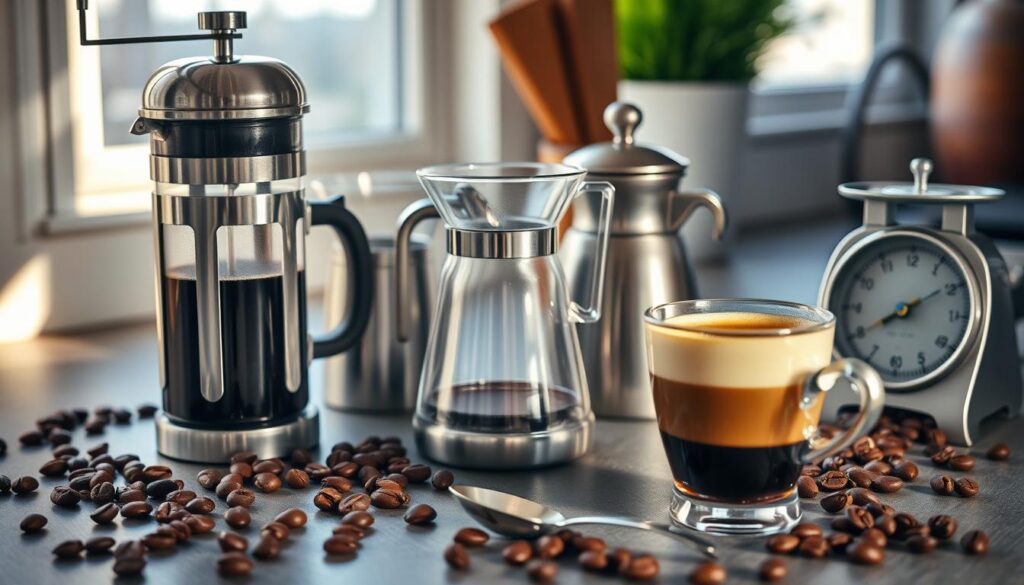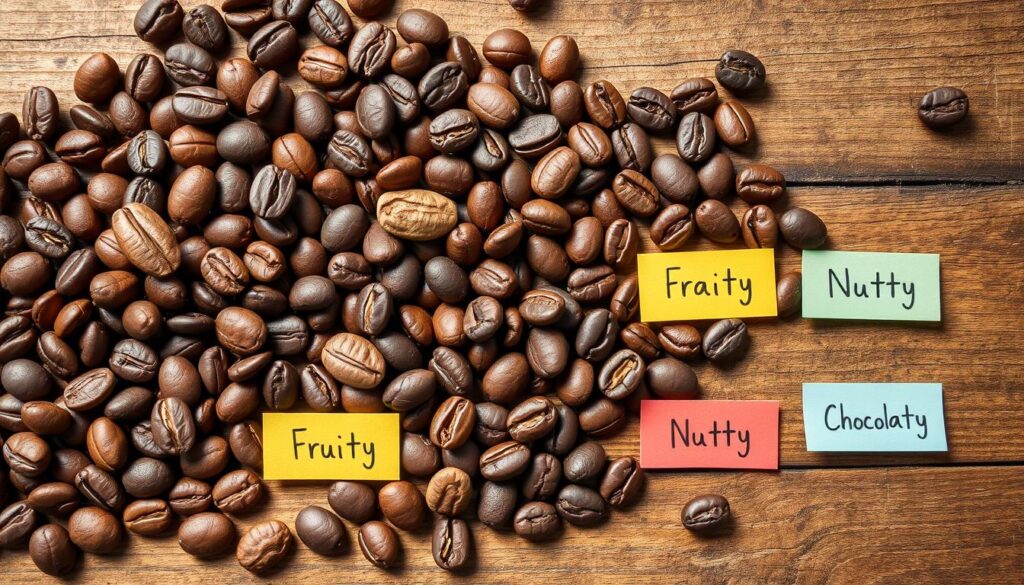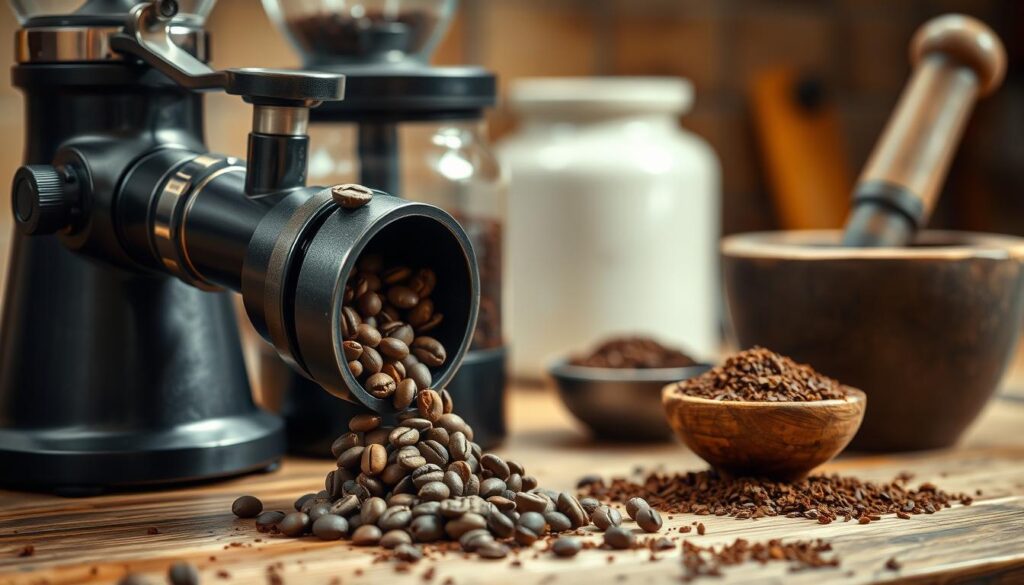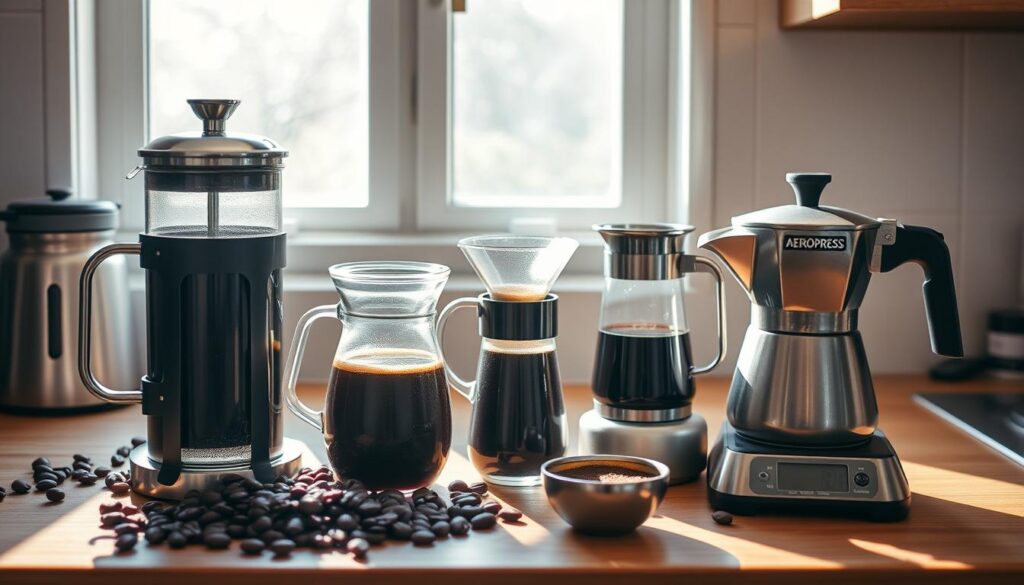Do you love rich, intense espresso but don’t want to spend a lot on a machine? You’re in good company. DIY espresso brewing is a big hit among coffee fans who want to make great coffee at home. They’re finding clever ways to make espresso that’s just as good as the store kind, but cheaper.
Making espresso at home is exciting and budget-friendly. It doesn’t matter if you’re watching your wallet or just love trying new things. Learning to make espresso at home can make your morning coffee routine much better.
Key Takeaways
- DIY espresso methods are cost-effective
- Home brewing techniques can produce professional-quality shots
- No expensive equipment is required
- Multiple alternative brewing methods exist
- Creativity enhances coffee experience
Understanding the Basics of Espresso Making
Espresso is more than a strong coffee. It’s a precise art that turns coffee beans into a rich, concentrated drink. The process involves coffee, water, and pressure, creating a unique experience.
What Makes Espresso Different from Regular Coffee
Espresso and regular coffee differ in several ways:
- Brewing time (20-30 seconds)
- High-pressure extraction method
- Fine coffee ground consistency
- Concentrated flavor profile
The Science Behind Pressure and Extraction
Pressure brewing is key to making espresso. It uses 9-10 bars of pressure to force hot water through fine coffee grounds. This creates intense flavors and the signature crema.
| Brewing Parameter | Espresso Specification |
|---|---|
| Water Temperature | 195-205°F |
| Pressure | 9-10 bars |
| Grind Size | Fine |
| Extraction Time | 20-30 seconds |
Key Elements of Perfect Espresso
Creating a perfect espresso shot requires mastering several key elements:
- Selecting high-quality coffee beans
- Achieving consistent fine grinding
- Maintaining precise water temperature
- Applying consistent pressure
“Espresso is the purest expression of coffee’s potential, captured in a single, powerful shot.” – Coffee Expert
Understanding these elements helps coffee lovers appreciate the art behind every espresso shot.
Essential Tools and Equipment for DIY Espresso

Making perfect espresso at home needs more than just love for coffee. The right tools can make all the difference. Professional baristas say quality equipment is key to great espresso.
Here are the main tools you’ll need for your home espresso station:
- Manual espresso makers
- Coffee grinders
- Coffee scales
- Tampers
- Temperature-controlled kettles
Now, let’s look at the most important tools for making espresso at home:
| Tool | Purpose | Recommended Type |
|---|---|---|
| Coffee Grinders | Consistent bean grinding | Burr grinders |
| Manual Espresso Makers | Brewing concentrated coffee | Flair, Rok, AeroPress |
| Coffee Scales | Precise ingredient measurement | Digital scales with 0.1g precision |
| Tampers | Compressing ground coffee | Flat-base, matched to portafilter size |
“The difference between good and great espresso often lies in the precision of your tools.” – Professional Barista
Getting quality home espresso tools doesn’t have to cost a lot. Start with the basics and add more as you get better.
Choosing the Right Coffee Beans for Your Homemade Espresso
Making the perfect homemade espresso begins with picking the right coffee beans. The quality and type of your coffee beans greatly affect the taste, smell, and overall espresso experience.

Best Roast Levels for Espresso
For espresso, dark and medium-dark roasts are the best. These roast levels offer rich, intense flavors that make a classic espresso.
- Dark roasts: Provide a bold, robust flavor with low acidity
- Medium-dark roasts: Offer a balanced taste with caramel and chocolate notes
- Avoid light roasts: They lack the depth required for traditional espresso
Single Origin vs. Espresso Blends
Deciding between single-origin coffee and espresso blends can be tough. Each has its own unique qualities that appeal to different tastes.
“The art of espresso is in understanding the nuanced flavors of your beans” – Coffee Master
| Single Origin | Espresso Blends |
|---|---|
| Distinct regional flavor profiles | Consistent, balanced taste |
| Highlight specific terroir | Designed for optimal espresso extraction |
Storage Tips for Maximum Freshness
Storing coffee beans properly is key to keeping their quality. Follow these tips to keep your espresso beans fresh and flavorful:
- Store in an opaque, airtight container
- Keep away from direct sunlight and heat
- Avoid refrigeration – room temperature is ideal
- Purchase small quantities to ensure freshness
Pro tip: Buy whole beans and grind just before brewing to preserve the most vibrant flavors.
The Importance of Proper Coffee Grinding

Grinding coffee is a key step in making the perfect espresso shot. The size of the grind affects the flavor, aroma, and quality of your espresso. Learning about grinding can turn a regular cup into a special experience.
For espresso, precision is crucial. The grind should be fine and even, like powdered sugar. Burr grinders are the best for this. They crush beans between two surfaces, unlike blade grinders that chop randomly.
“Consistency in grinding is the secret weapon of exceptional espresso.” – Professional Barista
- Fine grind allows for optimal water extraction
- Uniform particle size ensures balanced flavor
- Prevents under or over-extraction
Different brewing methods need different grind sizes. For espresso, you need an ultra-fine grind for quick, high-pressure extraction.
| Grinder Type | Grind Consistency | Espresso Performance |
|---|---|---|
| Blade Grinder | Inconsistent | Poor |
| Burr Grinder | Extremely Consistent | Excellent |
Pro tip: Invest in a high-quality burr grinder for the best espresso grinding results. Your taste buds will thank you!
How to Make Espresso at Home Without an Espresso Machine
Coffee lovers can make espresso-style drinks at home. They can use manual methods to get rich, concentrated coffee. This way, you don’t need to buy expensive espresso machines.

Traditional espresso machines use high pressure. But, you can get similar results at home with creative brewing. Let’s look at three popular manual methods to change your coffee game.
The Moka Pot Espresso Technique
Moka pot espresso is a strong brewing method. It uses a stovetop device to make coffee that’s like traditional espresso.
- Use finely ground coffee beans
- Fill the bottom chamber with water
- Add ground coffee to the filter basket
- Heat on medium-low flame
- Remove from heat when brewing completes
The AeroPress Espresso Approach
AeroPress espresso is quick and versatile. This small device lets you control the coffee’s strength and flavor.
- Place micro-filter in the AeroPress
- Add finely ground coffee
- Pour hot water (around 200°F)
- Stir briefly
- Press down firmly to extract
French Press Espresso Style
French press espresso makes a rich, full-bodied coffee. It’s not traditional espresso, but it has intense flavors.
| Method | Brew Time | Intensity |
|---|---|---|
| Moka Pot | 5-10 minutes | High |
| AeroPress | 2-3 minutes | Medium-High |
| French Press | 4-5 minutes | Medium |
“Great espresso isn’t about expensive equipment, but understanding brewing techniques.” – Coffee Expert
Each manual espresso method has its own charm. Try different techniques to find your favorite brew.
Achieving the Perfect Crema Without a Machine
Getting a rich espresso crema at home without a fancy machine might seem hard. But, with some tricks, you can get that espresso texture you love. It’s all about mastering the art of manual brewing crema.
To make faux crema, you need to know how to extract coffee well. Different ways to brew can help you get that golden layer, like from high-pressure espresso machines.
- Use freshly roasted coffee beans
- Grind beans to a fine, consistent texture
- Apply gentle pressure during brewing
- Experiment with water temperature
“The beauty of espresso is not in the machine, but in the passion of the brew.”
For those who love to brew, methods like the AeroPress or French Press can help. It’s all about how oils and tiny coffee particles mix during brewing.
| Brewing Method | Crema Quality | Difficulty Level |
|---|---|---|
| AeroPress | Good | Easy |
| French Press | Moderate | Medium |
| Moka Pot | Excellent | Challenging |
Pro tip: Fresh beans and the right grind are more important than fancy gear for great espresso crema.
Common Mistakes to Avoid When Making DIY Espresso
Making perfect espresso at home can be tough. To fix this, knowing common coffee brewing errors is key. These errors stop home baristas from getting cafe-quality shots.
Professional baristas see making espresso as an art. Every step in brewing can lead to problems. These problems can greatly affect your drink’s quality.
Temperature Control Issues
Water temperature is very important for extraction. The best temperature for espresso is between 195-205°F. If the temperature is off, you might get:
- Under-extracted, sour espresso
- Over-extracted, bitter espresso
- Bad crema
Grinding Mistakes
Grinding coffee wrong can ruin your espresso. Uniform coffee particle size is critical for good extraction. Common mistakes include:
- Using blade grinders instead of burr grinders
- Grind size not being consistent
- Grinding too early
Pressure Problems
Pressure is crucial for a great espresso. Without the right pressure, you can’t get the rich flavors of a good shot.
“Consistent pressure is the secret to exceptional espresso.” – Coffee Experts Collective
By knowing these key areas, home baristas can improve their brewing. They can make professional-quality espresso right at home.
Tips for Creating Espresso-Based Drinks at Home
Making tasty espresso drinks at home is simpler than you think. With a few easy steps, you can make professional-quality drinks in your kitchen.
Milk frothing is key for creamy lattes and cappuccinos. You don’t need fancy gear to get it right. A manual frother or even a whisk can make your espresso drinks rich and smooth.
“The art of espresso is in the details, not the expensive machinery.”
- Essential ingredients for homemade espresso drinks:
- Fresh espresso shots
- Cold milk (whole milk works best)
- Optional flavoring syrups
Making Americanos is easy. Just add hot water to your espresso to make it less strong. For cappuccinos, mix equal parts espresso, steamed milk, and foam.
| Drink | Espresso Ratio | Milk Ratio |
|---|---|---|
| Latte | 1/3 espresso | 2/3 steamed milk |
| Cappuccino | 1/3 espresso | 1/3 steamed milk, 1/3 foam |
| Americano | 1 shot espresso | Hot water to taste |
Pro tip: The right temperature is crucial! Heat your milk between 140-160°F for the best brewing experience. Keep practicing, and you’ll soon make cafe-quality drinks at home.
Troubleshooting Your Homemade Espresso
Fixing espresso issues at home can be tough. To make perfect espresso, you need to know how to solve common problems. These problems can affect your coffee’s taste and quality.
Every coffee lover faces brewing challenges. Here are some key tips to help you make a tasty espresso at home.
Fixing Bitter Coffee
Bitter coffee usually comes from over-extraction or water that’s too hot. To fix this:
- Reduce extraction time
- Use slightly coarser ground coffee
- Lower water temperature to 195-205°F
- Check coffee bean roast quality
Addressing Under-Extracted Espresso
An under-extracted espresso tastes sour or weak. To fix this, try:
- Grinding coffee more finely
- Increasing brewing time
- Ensuring consistent tamping pressure
- Using fresh, high-quality beans
Solving Coffee Temperature Issues
Temperature is crucial for espresso extraction. Precision is key for the perfect brew.
“Temperature control separates good espresso from great espresso.” – Professional Barista
Make sure your brewing equipment’s temperature is stable. Use a reliable thermometer to keep the brewing conditions just right.
Conclusion
Making great espresso at home is easier than you think. With the right DIY techniques, anyone can become skilled without spending a lot on equipment. Trying out methods like the Moka pot, AeroPress, and French press can lead to rich, bold coffee.
Home brewing saves money and offers more than just that. Learning about coffee beans, grinding, and extraction can make your morning coffee special. Every try gets you closer to making that perfect shot, just like in cafes.
Getting good at home espresso takes practice and patience. Start simple, try different beans, and keep improving. Every barista started where you are now, eager to learn. Your espresso journey is about finding flavor, mastering technique, and enjoying the process.
Now you have the tools to improve your coffee. Whether you love coffee or want to be a home barista, amazing espresso is yours to make. Enjoy the journey, try new things, and relish the taste of your hard work.
FAQ
Can I really make espresso at home without an expensive machine?
Yes, you can! Use a Moka pot, AeroPress, or French press to make espresso-style coffee at home. These methods might not be as good as a professional machine. But, with practice, they can get very close.
What kind of coffee beans work best for homemade espresso?
Choose medium to dark roast beans, especially those labeled for espresso. Espresso blends offer a rich flavor. Single-origin beans from Brazil, Colombia, or Ethiopia also work well.
How important is grinding when making DIY espresso?
Grinding is key! You need a fine, consistent grind, like table salt. Use a burr grinder for even particles. This ensures good extraction and flavor.
What’s the biggest challenge when making espresso without a machine?
Getting the right pressure and extraction is hard. Each method has its own issues. For example, keeping pressure steady with a Moka pot or finding the right brewing time with an AeroPress.
Can I make milk-based drinks like lattes at home?
Yes! Make delicious cappuccinos, lattes, and more with your homemade espresso. Use a milk frother or whisk. The trick is mastering milk frothing and getting the right ratio of milk to espresso.
How do I avoid making bitter espresso?
Bitter espresso comes from over-extraction or too hot water. Use water between 195-205°F. Don’t over-brew and make sure your grind is right for your method.
What’s the most beginner-friendly method for making espresso at home?
The AeroPress is great for beginners. It’s affordable, easy to use, and produces clean-tasting coffee. Plus, it lets you control brewing more than other manual methods.
How can I create crema without an espresso machine?
Creating true crema without high pressure is hard. But, use freshly roasted, ground beans. Try the inverted AeroPress method or a Moka pot with fresh, fine coffee.
Share this post: on Twitter on Facebook

